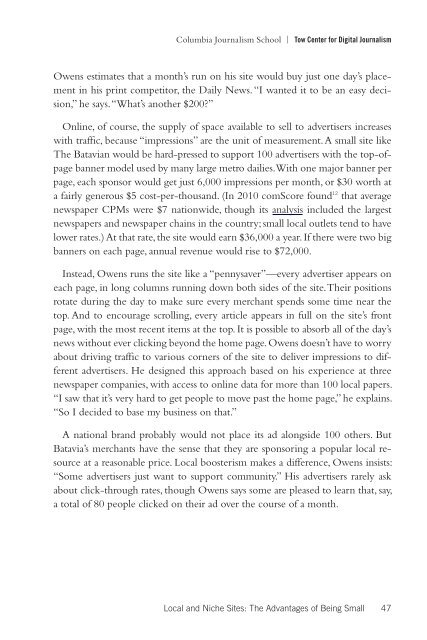What We Know About the Business of Digital Journalism
What We Know About the Business of Digital Journalism
What We Know About the Business of Digital Journalism
Create successful ePaper yourself
Turn your PDF publications into a flip-book with our unique Google optimized e-Paper software.
Columbia <strong>Journalism</strong> School | Tow Center for <strong>Digital</strong> <strong>Journalism</strong>Owens estimates that a month’s run on his site would buy just one day’s placementin his print competitor, <strong>the</strong> Daily News. “I wanted it to be an easy decision,”he says. “<strong>What</strong>’s ano<strong>the</strong>r $200?”Online, <strong>of</strong> course, <strong>the</strong> supply <strong>of</strong> space available to sell to advertisers increaseswith traffic, because “impressions” are <strong>the</strong> unit <strong>of</strong> measurement. A small site likeThe Batavian would be hard-pressed to support 100 advertisers with <strong>the</strong> top-<strong>of</strong>pagebanner model used by many large metro dailies. With one major banner perpage, each sponsor would get just 6,000 impressions per month, or $30 worth ata fairly generous $5 cost-per-thousand. (In 2010 comScore found 12 that averagenewspaper CPMs were $7 nationwide, though its analysis included <strong>the</strong> largestnewspapers and newspaper chains in <strong>the</strong> country; small local outlets tend to havelower rates.) At that rate, <strong>the</strong> site would earn $36,000 a year. If <strong>the</strong>re were two bigbanners on each page, annual revenue would rise to $72,000.Instead, Owens runs <strong>the</strong> site like a “pennysaver”—every advertiser appears oneach page, in long columns running down both sides <strong>of</strong> <strong>the</strong> site. Their positionsrotate during <strong>the</strong> day to make sure every merchant spends some time near <strong>the</strong>top. And to encourage scrolling, every article appears in full on <strong>the</strong> site’s frontpage, with <strong>the</strong> most recent items at <strong>the</strong> top. It is possible to absorb all <strong>of</strong> <strong>the</strong> day’snews without ever clicking beyond <strong>the</strong> home page. Owens doesn’t have to worryabout driving traffic to various corners <strong>of</strong> <strong>the</strong> site to deliver impressions to differentadvertisers. He designed this approach based on his experience at threenewspaper companies, with access to online data for more than 100 local papers.“I saw that it’s very hard to get people to move past <strong>the</strong> home page,” he explains.“So I decided to base my business on that.”A national brand probably would not place its ad alongside 100 o<strong>the</strong>rs. ButBatavia’s merchants have <strong>the</strong> sense that <strong>the</strong>y are sponsoring a popular local resourceat a reasonable price. Local boosterism makes a difference, Owens insists:“Some advertisers just want to support community.” His advertisers rarely askabout click-through rates, though Owens says some are pleased to learn that, say,a total <strong>of</strong> 80 people clicked on <strong>the</strong>ir ad over <strong>the</strong> course <strong>of</strong> a month.Local and Niche Sites: The Advantages <strong>of</strong> Being Small 47
















